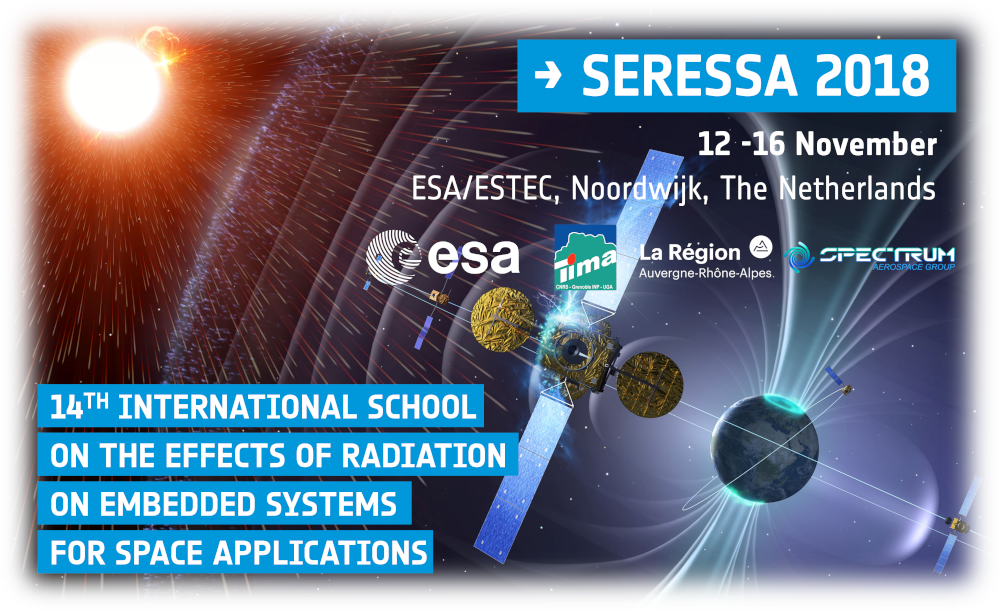Speaker
Description
I. ABSTRACT
The Single Event Upset (SEU) characterization of electronic components, requiring characteristics of radiation-hardness and employed in high-energy accelerators, relies on the knowledge of high-energy hadron cross sections typically measured with high-energy protons. Preliminary irradiation tests performed with an Americium-Beryllium (Am-Be) neutron source at CERN, demonstrated that this radiation environment can be used to induce SEUs in commercial SRAM memories. The source provides a spectrum with a peak around 3 MeV and reaches a maximum energy of about 10 MeV as shown in Fig. 1. This is a simulated spectrum thought the Monte Carlo FLUKA tool [1], [2]. The source employed for the tests presents an omnidirectional flux of 5.03×107 [s-1] and the activity of 888 GBq [3].
The ESA SEU Reference Monitor [4] (0.25 μm CMOS technology) and a Cypress 90 nm commercial SRAM were qualified with the aforementioned Am-Be source. The former is an SRAM-based detector calibrated in a broad set of facilities and used by the R2E group at CERN to cross validate the facility flux. In addition, it shows the beam homogeneity over its 20x20mm2 of active surface. The Cypress memory is the one embedded in the RadMon system [5], the radiation monitor used to measure the High Energy Hadrons (HEH) flux along the LHC accelerator.
The source and irradiation room were modelled thought FLUKA in order to estimate the flux of the source at the desired distance. Tests with the ESA Monitor were performed in different positions along the three axis with respect to the source, with the aim of evaluating in a qualitative way the flux attenuation and in comparison with the simulations [6] (see Fig. 2).
By weighting the neutron flux (derived through FLUKA simulations) impinging the active area of the device with the respective Weibull response, the agreement on the retrieved cross section with that obtained from high-energy protons (200 MeV) is within the experimental uncertainty. The same agreement applies in terms of expected upsets by convoluting the neutron flux and calibrated SEU response, both as a function of energy. Indirectly, experimental observations have shown that the cross section calculated with the specific Weibull fit is applicable to different particle energy spectra. The Am-Be source can therefore induce a statistically significant amount of SEUs in a relatively reduced timeframe (~hours). Its employment can therefore be aimed at screening the SEU sensitivity of SRAM memories in a more accessible and cost efficient way compared to high-energy cyclotron proton testing.
REFERENCES
[1] A. Ferrari, P. R. Sala, A. Fasso, and J. Ranft, “FLUKA: A Multi-Particle Transport Code,” SLAC-R-773, 877507, Dec. 2005.
[2] G. Battistoni et al., “The FLUKA code: description and benchmarking,” in AIP Conference Proceedings, Batavia, Illinois (USA), 2007, vol. 896, pp. 31–49
[3] F. Pozzi, “CERN Radiation Protection (RP) calibration facilities,” Ph.D dissertation, Fac. Mechanical Engineering, Technical Univ. of Munich., Sept. 2015.
[4] R. Harboe-Sorensen et al., “From the Reference SEU Monitor to the Technology Demonstration Module On-Board PROBA-II,” IEEE Trans. Nucl. Sci., vol. 55, no. 6, pp. 3082–3087, Dec. 2008.
[5] G. Spiezia et al., “A New RadMon Version for the LHC and its Injection Lines.” IEEE Trans. Nucl. Sci., vol. 61, no. 6, pp. 3424-3431, Dec. 2014.
[6] M. Cecchetto, “Impact of thermal and intermediate energy neutrons on the semiconductor memories for the CERN high-energy accelerators,” M.S. thesis, Dept of Information Eng., Padova Univ., July 2017.

